
The Maple Leaf is an international passenger train service operated by Amtrak and Via Rail between New York Penn Station in New York City and Union Station in Toronto via the Empire Corridor. Daily service is offered in both directions; the 544-mile (875 km) trip takes approximately 12 hours, including two hours for U.S. or Canadian customs and immigration inspection at either Niagara Falls, New York, or Niagara Falls, Ontario. Although the train uses Amtrak rolling stock exclusively, the train is operated by Via Rail crews while in Canada and by Amtrak crews in the United States. Service began in 1981.
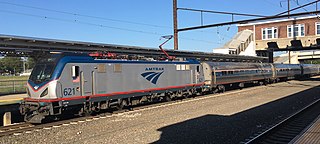
The Keystone Service is a 195 mile regional passenger train service from Amtrak between the Harrisburg Transportation Center in Harrisburg, Pennsylvania, and 30th Street Station in Philadelphia, running along the Philadelphia to Harrisburg Main Line. Most trains continue along the Northeast Corridor (NEC) to Penn Station in New York City.

Metra is the primary commuter rail system in the Chicago metropolitan area serving the city of Chicago and its surrounding suburbs via the Union Pacific Railroad, BNSF Railway, and other railroads. The system operates 242 stations on 11 rail lines. It is the fourth busiest commuter rail system in the United States by ridership and the largest and busiest commuter rail system outside the New York City metropolitan area. In 2023, the system had a ridership of 31,894,900, or about 152,400 per weekday as of the fourth quarter of 2023. The estimated busiest day for Metra ridership occurred on November 4, 2016—the day of the Chicago Cubs 2016 World Series victory rally.

The Hiawatha Service, or simply Hiawatha, is an 86-mile (138 km) train route operated by Amtrak on the western shore of Lake Michigan between Chicago, Illinois, and Milwaukee, Wisconsin. However, the name was historically applied to several different routes that extended across the Midwest and to the Pacific Ocean. As of 2007, twelve to fourteen trains ran daily between Chicago and Milwaukee, making intermediate stops in Glenview, Illinois; Sturtevant, Wisconsin; and Milwaukee Mitchell International Airport. The line is partially supported by funds from the state governments of Wisconsin and Illinois. The line utilizes the CPKC Railway's C&M Subdivision and Metra's Milwaukee District North Line.

The Trinity Railway Express (TRE) is a commuter rail service in the Dallas–Fort Worth metroplex, Texas, United States. It was established by an interlocal agreement between Dallas Area Rapid Transit (DART) and Trinity Metro. Each transit authority owns a 50% stake in the joint rail project and contractor Herzog Transit Services operates the line. The TRE began operating in December 1996.

MARC is a commuter rail system in the Washington–Baltimore area. MARC is administered by the Maryland Transit Administration (MTA) and operated under contract by Alstom and Amtrak on track owned by CSX Transportation (CSXT) and Amtrak. In 2023, the system had a ridership of 3,860,600, or about 12,400 per weekday as of the fourth quarter of 2023, less than pre-COVID-19 pandemic weekday ridership of 40,000.
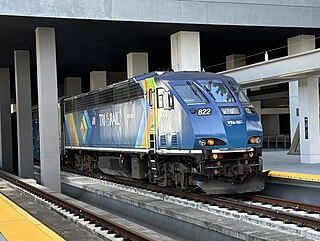
Tri-Rail is a commuter rail service linking Miami, Fort Lauderdale and West Palm Beach in Florida, United States. The Tri prefix in the name refers to the three counties served by the railroad: Palm Beach, Broward, and Miami-Dade. Tri-Rail is managed by the South Florida Regional Transportation Authority (SFRTA) along CSX Transportation's former Miami Subdivision; the line is now wholly owned by the Florida DOT. The 80.0-mile-long (128.7 km) system has 19 stations along the Southeast Florida coast, and connects directly to Amtrak at numerous stations, to Metrorail at the Metrorail Transfer station, Miami Airport station, and MiamiCentral, and to Brightline at MiamiCentral.

The Northstar Line is a commuter rail route in the US state of Minnesota. Northstar runs 40 miles (64 km) from Big Lake to downtown Minneapolis at Target Field using existing track and right-of-way owned by the BNSF Railway. Passenger service began on November 16, 2009. The rail line serves part of the Northstar Corridor between Minneapolis and St. Cloud. Planning for the line began in 1997 when the Northstar Corridor Development Authority (NCDA) was formed. The corridor is also served by Interstate 94 and U.S. Highway 10. In 2023, the system had a ridership of 142,200, or about 500 per weekday as of the fourth quarter of 2023.

The Altamont Corridor Express is a commuter rail service in California, connecting Stockton and San Jose during peak hours only. ACE is named for the Altamont Pass, through which it runs. Service is managed by the San Joaquin Regional Rail Commission, and operations are contracted to Herzog Transit Services. The 86-mile (138 km) route includes ten stops, with travel time about 2 hours and 12 minutes end-to-end. In 2023, the line had a ridership of 576,300, or about 2,500 per weekday as of the fourth quarter of 2023. ACE uses Bombardier BiLevel Coaches, MPI F40PH-3C locomotives, and Siemens Charger locomotives.

The MBTA Commuter Rail system serves as the commuter rail arm of the Massachusetts Bay Transportation Authority's (MBTA's) transportation coverage of Greater Boston in the United States. Trains run over 394 mi (634 km) of track to 134 stations. It is operated under contract by Keolis, which took over operations on July 1, 2014, from the Massachusetts Bay Commuter Railroad Company (MBCR).

The Downeaster is a 145-mile (233 km) passenger train service operated by Amtrak and managed by the Northern New England Passenger Rail Authority (NNEPRA), an agency of the state of Maine. Named for the Down East region of Maine, the train operates five daily round trips between North Station in Boston, Massachusetts, and Brunswick, Maine, with ten intermediate stops.

The Silver Star is a long-distance passenger train operated by Amtrak on a 1,522-mile (2,449 km) route between New York City and Miami via Washington, D.C., Richmond, Virginia, Raleigh, North Carolina, Columbia, South Carolina, Savannah, Georgia, Jacksonville, Florida, and Tampa, Florida. The Silver Star and its sister train in the Silver Service brand, the Silver Meteor, are the descendants of numerous long-distance trains that operated between Florida and New York for most of the 20th century.
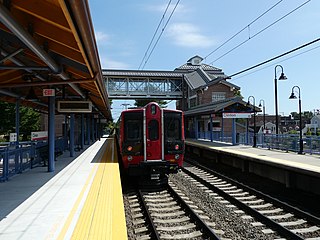
Shore Line East (SLE) is a commuter rail service which operates along the Northeast Corridor through southern Connecticut, United States. The rail service is a fully owned subsidiary of the Connecticut Department of Transportation (CTDOT) and is operated under the CT Rail brand. SLE provides service seven days a week along the Northeast Corridor between New London and New Haven; limited through service west of New Haven to Bridgeport and Stamford has been suspended since 2020. Cross-platform transfers to Metro-North Railroad New Haven Line trains are available at New Haven for service to southwestern Connecticut and New York City. Pre-COVID, around 2,200 riders used the service on weekdays.

Commuter rail services in the United States, Canada, Cuba, Mexico, Panama, and Costa Rica provide common carrier passenger transportation along railway tracks, with scheduled service on fixed routes on a non-reservation basis, primarily for short-distance (local) travel between a central business district and adjacent suburbs and regional travel between cities of a conurbation. It does not include rapid transit or light rail service.

The SEPTA Regional Rail system is a commuter rail network owned by SEPTA and serving the Philadelphia metropolitan area. The system has 13 branches and more than 150 active stations in Philadelphia, Pennsylvania, its suburbs and satellite towns and cities. It is the sixth-busiest commuter railroad in the United States, and the busiest outside of the New York, Chicago, and Boston metropolitan areas. In 2016, the Regional Rail system had an average of 132,000 daily riders and 118,800 daily riders as of 2019.

The Atlantic City Line (ACL) is a commuter rail line operated by NJ Transit (NJT) in the United States between Philadelphia, Pennsylvania and Atlantic City, New Jersey, operating along the corridor of the White Horse Pike. It runs over trackage that was controlled by both the Pennsylvania Railroad (PRR) and the Pennsylvania-Reading Seashore Lines. It shares trackage with SEPTA and Amtrak on the Northeast Corridor (NEC) until it crosses the Delaware River on Conrails Delair Bridge into New Jersey.

The BNSF Line is a Metra commuter rail line operated by the BNSF Railway in Chicago and its western suburbs, running from Chicago Union Station to Aurora, Illinois. In 2010, the BNSF Line continued to have the highest weekday ridership of the 11 Metra lines. While Metra does not refer to its lines by particular colors, the BNSF line's color on Metra timetables is "Cascade Green," in honor of the Burlington Northern Railroad.
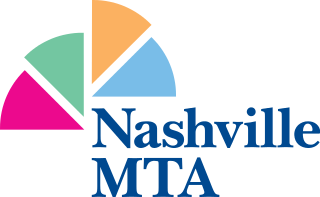
The Nashville Metropolitan Transit Authority, which does business as WeGo Public Transit, is a public transportation agency based in Nashville, Tennessee. Consisting of city buses and paratransit, the system serves Nashville and Davidson County. In 2023, the system had a ridership of 7,634,900, or about 27,700 per weekday as of the fourth quarter of 2023. For 2023, the Nashville MTA expected to collect $5.2 million in fare revenue and to spend $99.3 million in operation. To make up most of the difference, MTA expected to collect subsidies from the city, state, and national governments.

The Hartford Line is a commuter rail service between New Haven, Connecticut, and Springfield, Massachusetts, using the Amtrak-owned New Haven–Springfield Line. The project is a joint venture between the states of Connecticut and Massachusetts, with support from the federal government as well. CT Rail-branded trains provide service along the corridor, and riders can use Hartford Line tickets to travel on board most Amtrak trains along the corridor at the same prices. The service launched on June 16, 2018.
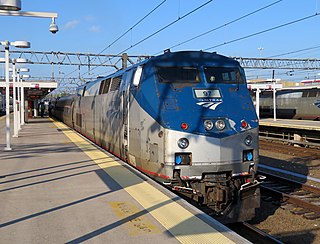
The Hartford Line is a train service run by Amtrak primarily between Springfield, Massachusetts, and New Haven, Connecticut, along Amtrak's New Haven–Springfield Line.

























